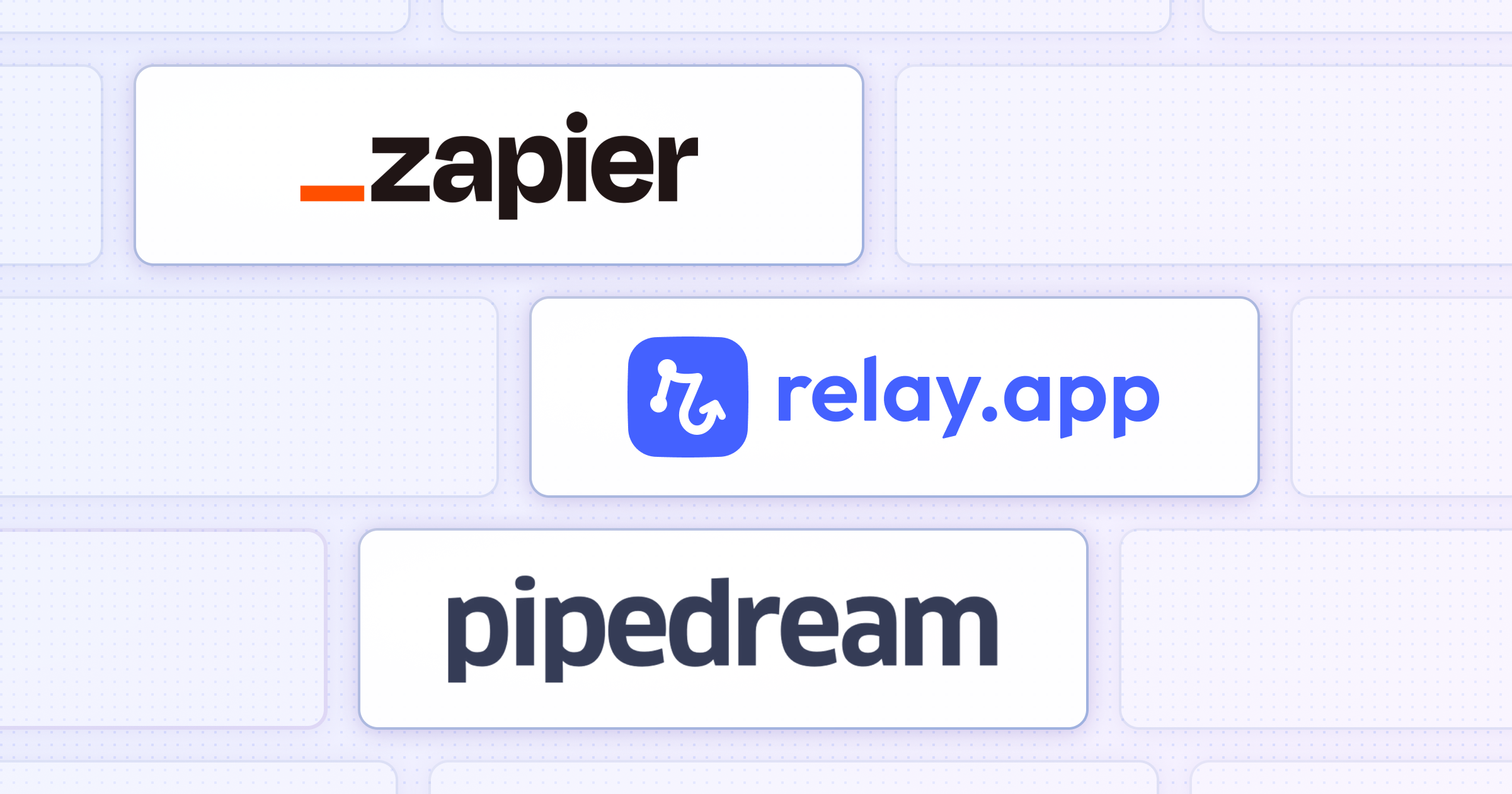
So, it has all come down to Pipedream vs Zapier vs Relay.app - all three amazing solutions can significantly improve your automation game - but here’s the question:
Which workflow automation tool is the best for your specific goals and needs?
We understand how crucial it is to find a platform whose capabilities are tailored to your pain points and requirements.
Also, we are aware that Relay.app isn’t everyone’s ideal choice.
In this article, we won’t try to convince you to choose our solution at all costs. We’ll just provide relevant and unbiased information on all three tools and let you decide for yourself.
In this comprehensive review, we’ll deep-dive into every solution’s:
- Key features
- Integrations
- Pricing structure
- User experience
In a nutshell, our research showed that:
- Relay.app is the ideal pick if you want to get all the benefits of streamlining your operations while keeping human judgment & creativity an essential part of automation.
- Pipedream is a low-code solution built for developers looking to boost their productivity via automation.
- Zapier is the perfect platform for users looking for a user-friendly solution with many integrations.
Let’s begin by dissecting each platform’s key features.
👀 Not a fan of reading lengthy articles? Run 100 free automations with Relay.app and see what it can do firsthand.
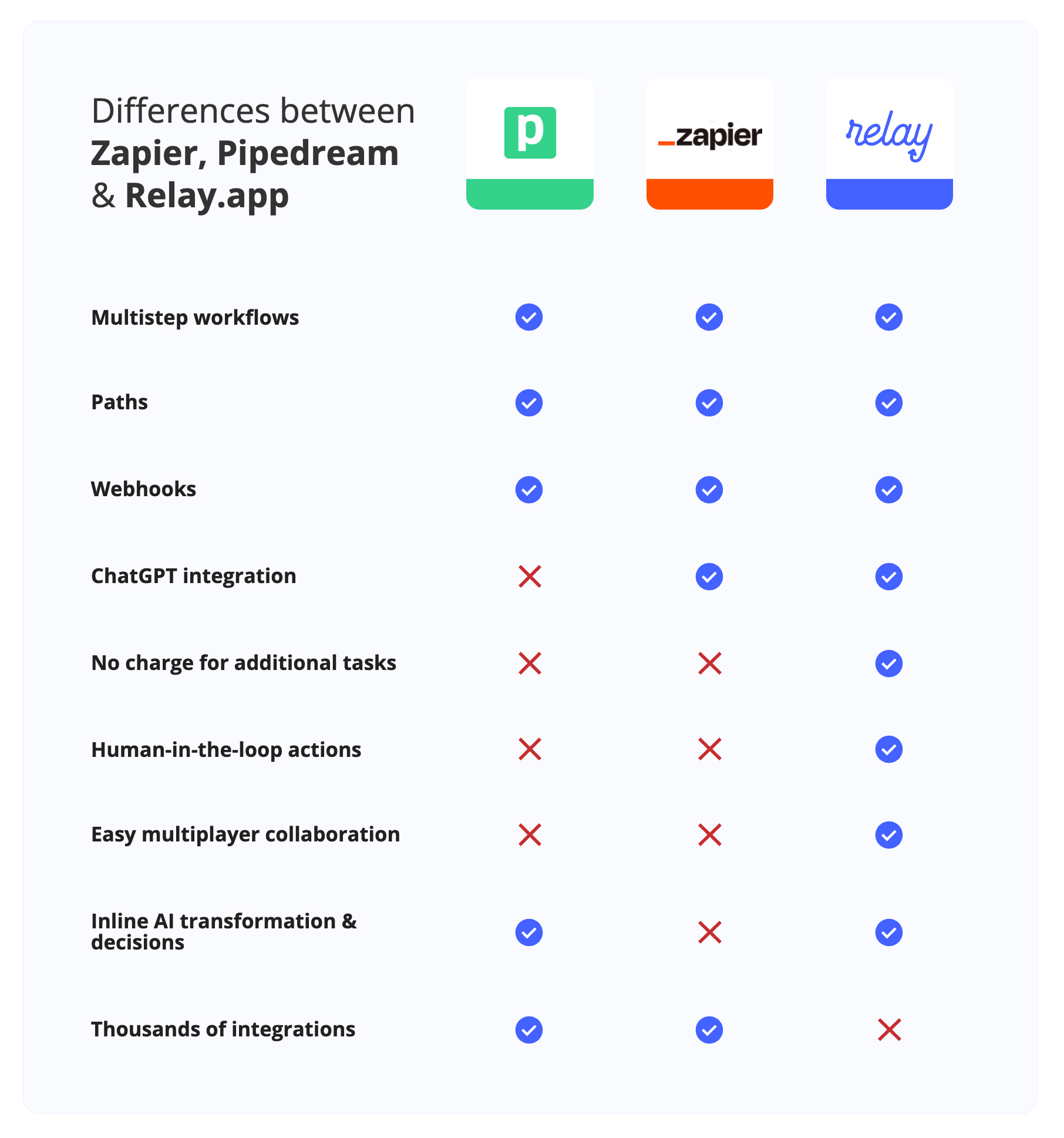
Features - Relay.app vs Pipedream vs Zapier
Each platform provides a unique user experience thanks to its distinct features and capabilities, which we’ll review here.
We’ll start by breaking down the features that set Relay.app apart from both Pipedream and Zapier.
Relay.app Features
Relay.app differs from other workflow automation tools because it combines human insight, creativity, and teamwork with powerful automation capabilities and a highly intuitive interface ⤵️
The features that allow Relay.app to provide its customers with the best of both worlds include:
- Human-in-the-Loop
- One-Click AI
- Collaborative Workflows
1. Human-in-the-Loop
Automation is a truly amazing thing.
By automating your business and other processes, you save time on repetitive tasks, increase overall productivity, and experience significant efficiency gains.
At the same time, however, you lose on several vital things - human precision, accountability, judgment, creative thinking, etc., as those traits remain beyond any software’s reach, no matter how sophisticated.
Relay.app’s Human-in-the-Loop feature solves this conundrum by letting you keep a human involved in your operations whenever needed while simultaneously automating and streamlining even the most complex workflows.
The magic comes when Relay.app lets you combine time-saving automations and human personalization.
For example, you can ask someone on your to write personalized welcome emails once tasks are automatically created in Asana when new customers are added to Mailchimp 👇
Other examples include:
Task approvals.
Let senior team members review and approve tasks before the automation continues. For example, you could have a manager approve a contract draft once it’s been automatically created as part of the workflow. After the approval, the workflow sends the DocuSign to the customer and waits for completion.
Human decisions.
Although Relay.app’s conditional logic capabilities allow for creating highly complex automations, in some cases, you’ll want a human to make the final decision instead of leaving it to automation. This is perfect for matters requiring contextual insight and understanding, such as customer support requests, where a support rep will decide whether to email the customer or create a support ticket in Zendesk.
Task completion.
Set up tasks and assign them to appropriate team members at any part of the workflow, and the automation will pause until the task is completed. For instance, after a deal is closed according to a CRM update, the sales manager is assigned a Task to create a contract draft. Once the manager drafts the contract, the workflow continues, and the document is shared with the other parties' legal counsel for review.
Manual data input.
A nifty option for all the times you need a pinch of emotional intelligence or original human insights. Use it to personalize email chains (e.g., have a team member manually edit headers or the body of the email for each customer), add personal notes and remarks to shared content, etc.

Why is the Human-in-the-Loop Feature Important?
If you’ve ever used workflow automation tools before, you know how frustrating it can be to:
- Monitor automations to ensure everything is running as it should.
- Bother with manually pausing workflows to add changes when needed.
- Struggle with personalizing complex workflows, etc.
Human-in-the-Loop lets you configure workflows without compromising on customer experience, allowing you to strike the right balance between operational speed and human contextual awareness.
Result? Get critical human inputs without disrupting or manually pausing workflows.
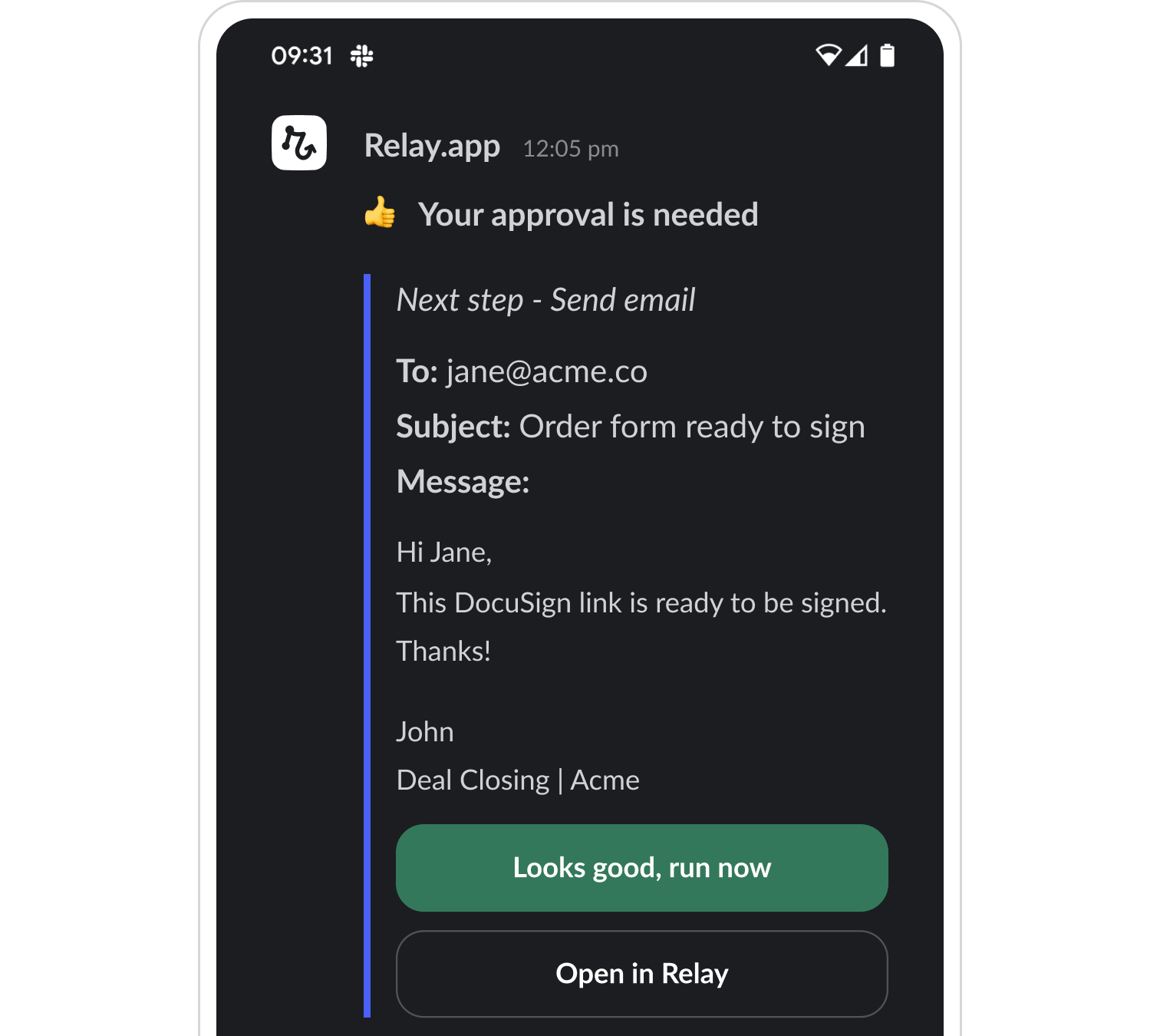
Expect significant improvements in overall efficiency and more customer wins.
Here’s a simple real-life example to help you get a better idea of this feature’s perks 👇
2. One-Click AI
AI is the next big thing in workflow automation, and for a good reason - it can make it even faster, easier to deploy, and more efficient.
However, getting AI to work as needed isn’t necessarily the easiest thing for non-technical teams.
Figuring out prompts is time-consuming and frustrating, as it requires employing the good, old, trial-and-error method.
With Relay.app’s pre-built contextual AI features, you can harness the full power of AI with a single click.
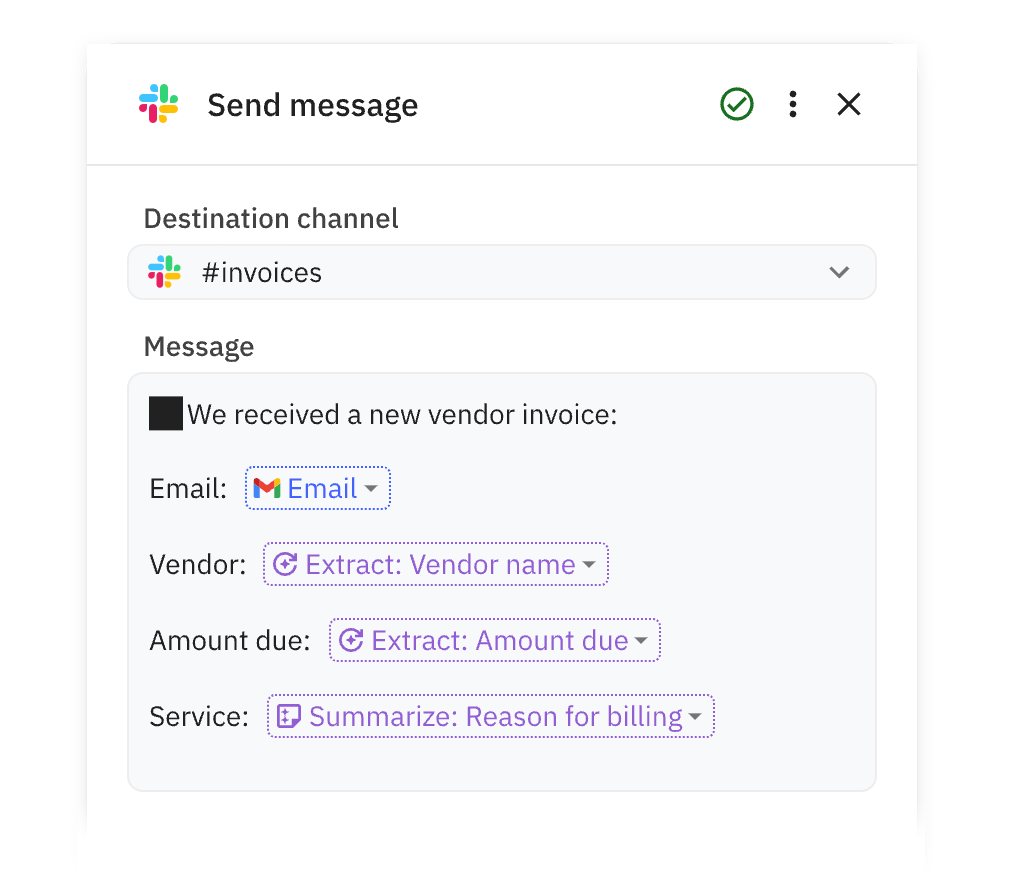
It allows for operations like:
- Summarizing different content (e.g., meeting notes, Notion guides, etc.)
- Generating in-context sentences and entire paragraphs to create various content even faster.
- Extracting relevant data from various sources such as emails, notes, etc.
What’s more, these AI-driven features can also help you detect errors in workflows and fix them without any coding skills.
3. Collaborative Workflows
Some projects can be completed in silos. Others require continuous teamwork.
Relay.app’s got options for both types of users and projects, enabling you to manage individual and collaborative workflows with equal ease and efficacy.
With dynamic role assignments, you can assign tasks to team members without disrupting the automated flow.
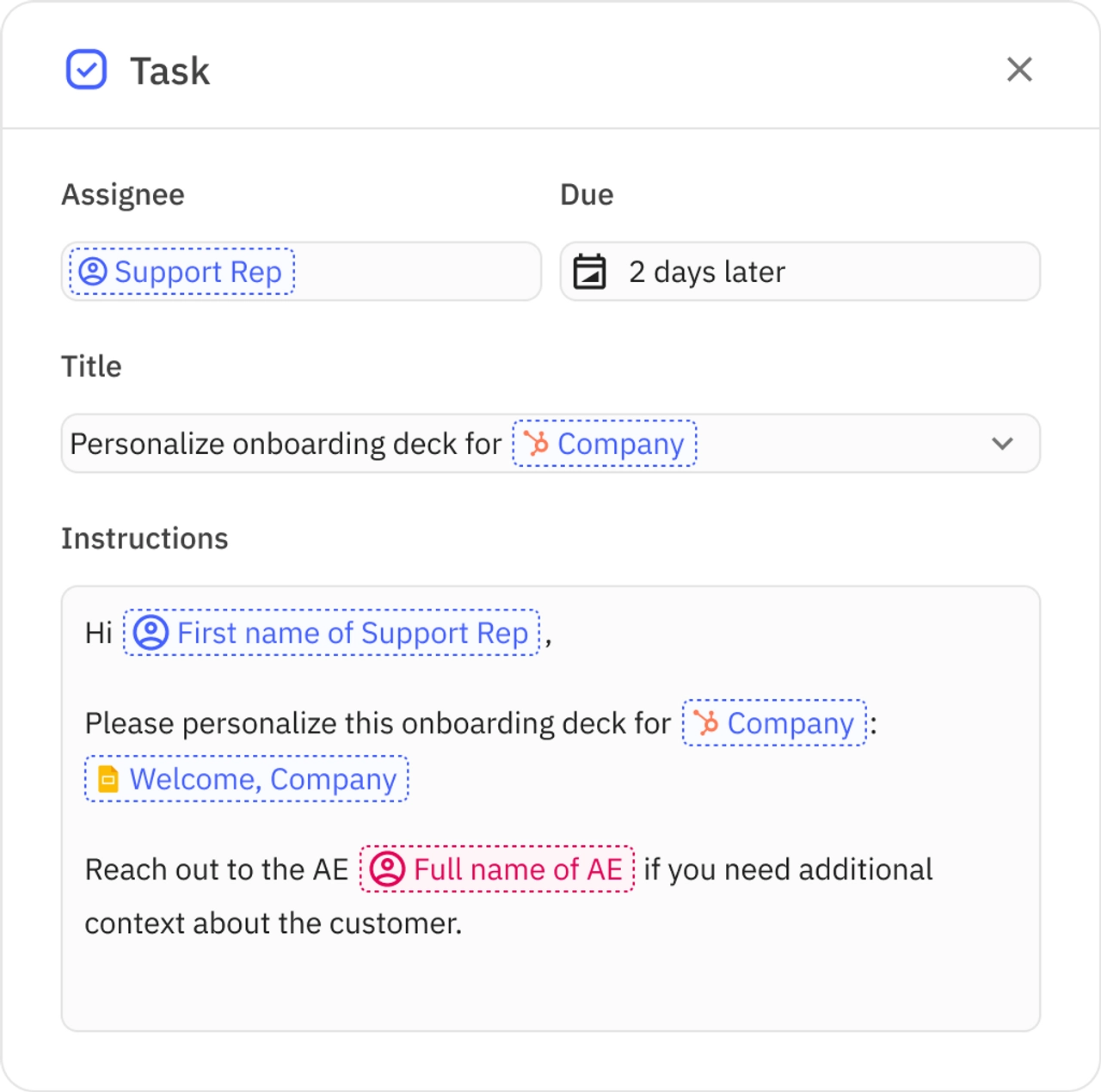
For example, you can automate and streamline processes such as:
- Forwarding customer support requests to the appropriate representative.
- Getting approval from specific decision-makers before sending contracts to clients.
- Assigning tasks to the most adequate Account Manager and more.
This way, the most competent person will handle each workflow step and task while ensuring that the entire team is on the same page.
Pipedream Features
Pipedream is a low-code automation and app integration platform designed for developers.
Since they’re geared toward its target users, Pipedream’s features are quite specific and require technical knowledge, including:
1. Access to npm & PyPI packages.
This is a dream feature for developers using JavaScript and Python, as it enables using most of npm's 400,000+ packages (for all the non-developers here, npm is a package manager for JavaScript), allowing advanced developers to become full-stack engineers with a single platform.
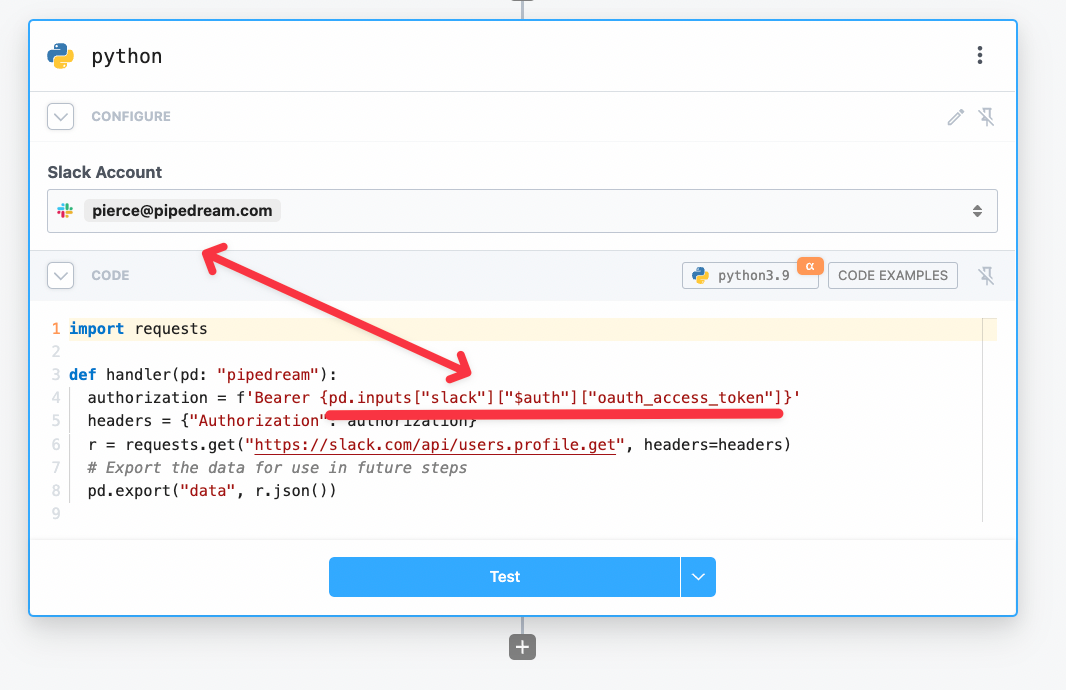
2. Workflow templates. Pipedream includes a solid library of pre-built automation templates if you don’t want to build automations from scratch.
Thanks to templates, users can deploy the needed automation in minutes. These templates are also based on community contributions, meaning every user can share their custom code for various automation processes.
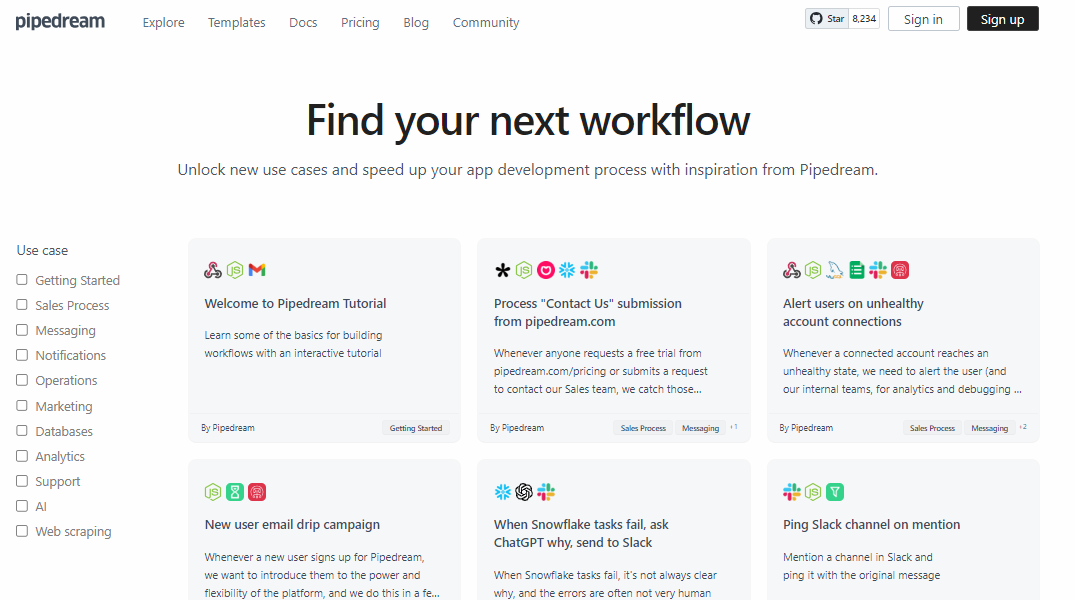
3. AI-powered workflow builder. Based on conversational AI models, this feature allows users to build custom workflows and manage complex data automation by explaining what they want to do in plain English.

Zapier Features
Zapier pioneered workflow automation and is known for its user-friendly interface, minimal learning curve, and versatile use cases.
Several features are contributing to Zapier’s popularity:
1. A visual workflow builder. Zapier is a no-code platform like Relay.app. It has an equally intuitive visual workflow builder that allows users to create custom workflows easily via a drag-and-drop interface.

2. Tables and Interfaces. Tables allow for collecting, sorting, storing, and pulling data from various apps and sources through a single platform.
Interfaces enable building simpler apps, custom dashboards, webpages, custom forms, etc. Keep in mind, though, that Zapier’s automation plans provide access only to the basic features of these tools.

3. AI assistant. Similarly to Pipedream, Zapier also has an AI-powered automation assistant that allows users to create simple and complex workflows by explaining what they need in natural language.

4. A library of 70+ ready-made automation templates. It includes ready-made automations, ranging from basic tasks to custom logic-based workflows. Enjoy the benefits of event-driven automation even if you’re not a workflow automation expert.
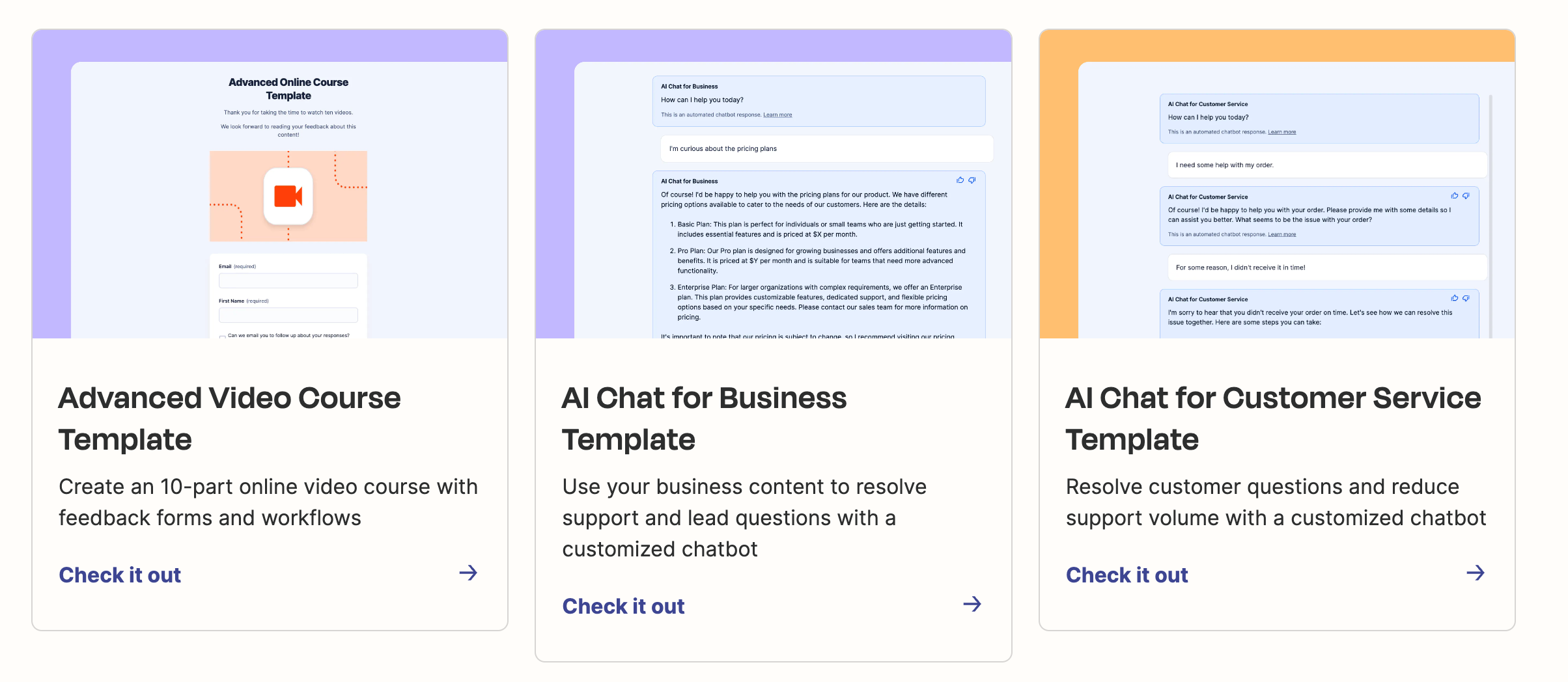
Integrations - Relay.app vs Zapier vs Pipedream
Relay.app
Relay.app currently integrates with a wide range of apps, including those that most users need for their daily tasks, such as:
- Apollo
- Google Suite
- Airtable
- Notion
- Slack, etc.
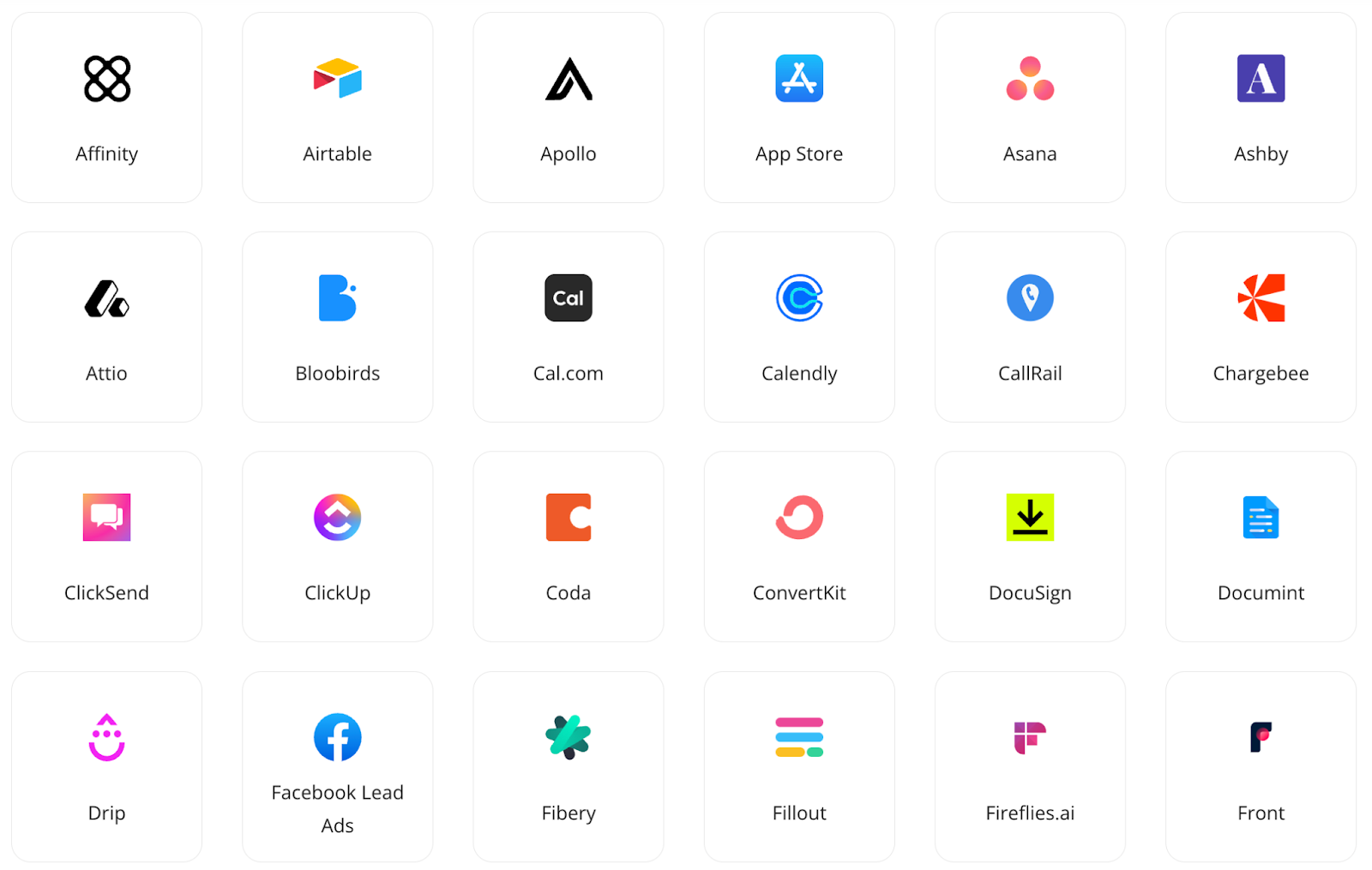
While Relay.app doesn’t have as many integrations as Zapier, our team is dedicated to frequently adding new apps, at the same time ensuring that all the existing integrations are robust and easy to deploy and support across workflows.
Pipedream
Pipedream supports about 2,000 different apps, with new ones being added regularly.
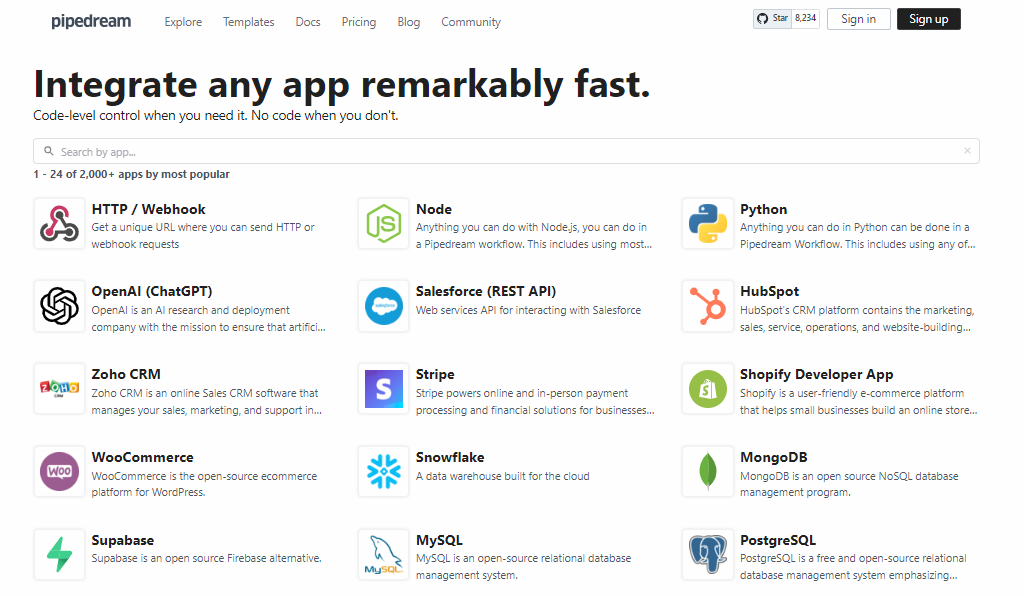
Some of its notable integrations include business apps such as Stripe and WooComerce,as well as those designed for developers, such as Node, Firebase Admin SDK, etc.
If the app you need isn’t included in Pipedream’s library, you can create custom integrations.
Zapier
Zapier is a market leader in integrations, with a library of over 7,000 apps that includes everything an average user may need.
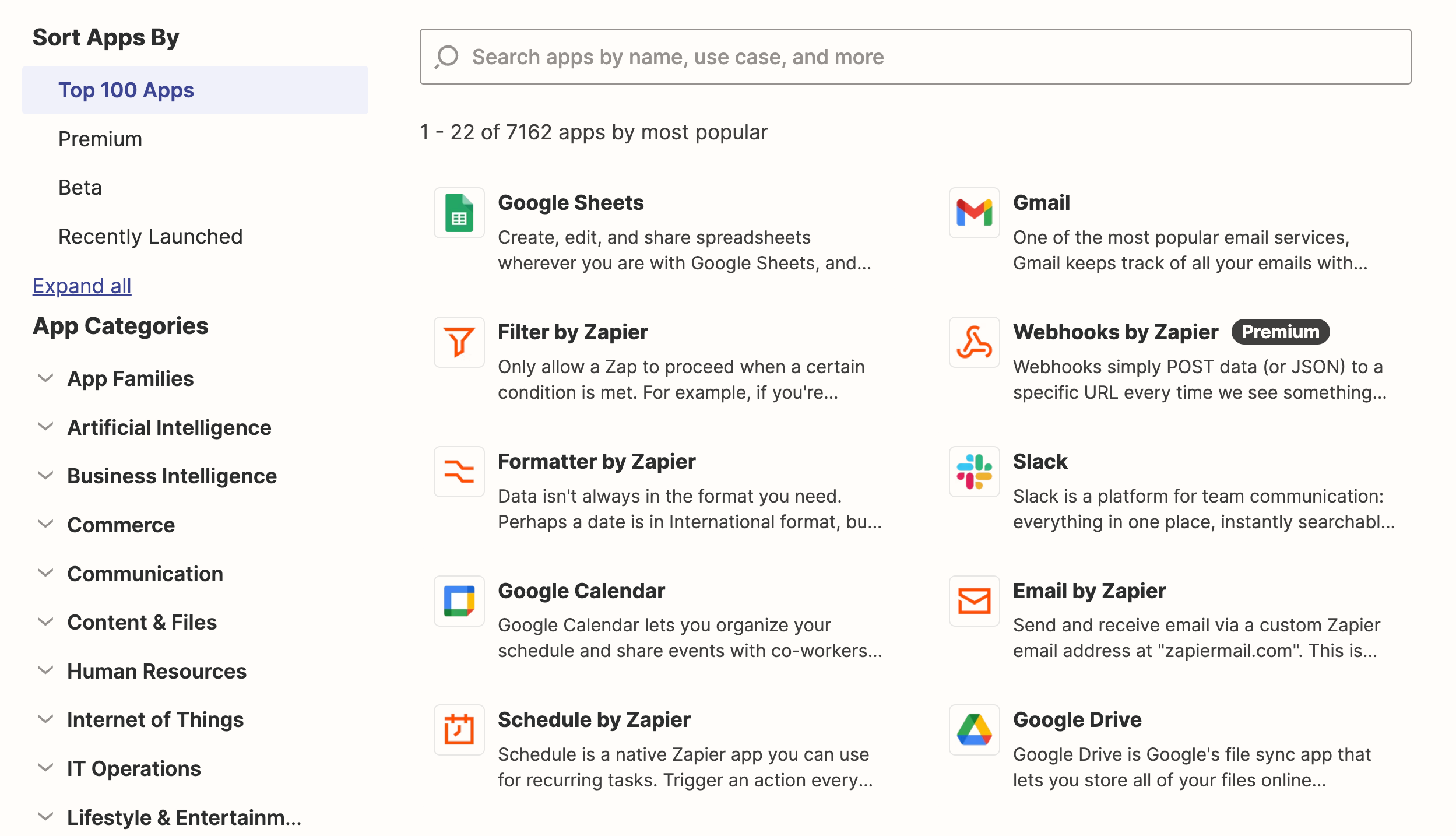
However, keep in mind that not all integrations work equally well. The popular and widely used apps are usually better integrated and supported than some more obscure ones.
Integrations in a nutshell
If your focus is on the number of integrations first and foremost, Zapier is the winner in this category, boasting the largest integration library.
Relay.app, on the other hand, doesn’t have as many integrations, but all the apps it does support work seamlessly across levels and workflows.
Finally, Pipedream has a decent range of integrations, emphasizing developer-designated apps.
Pricing - Relay.app vs Pipedream vs Zapier
Price is one of the key factors when deciding on an automation solution, so let’s quickly review all three solutions’ pricing structures.
Relay.app
With Relay.app, you get to run 100 automations for free, with unlimited access to all its features.
For users needing more, there are three plans to choose from:
- Starter: $18 per month (2 users included)
- Team: Starting at $27 per month ($9 per seat, includes 3-20 users)
- Enterprise: Custom pricing for larger-scale users requiring 20+ seats
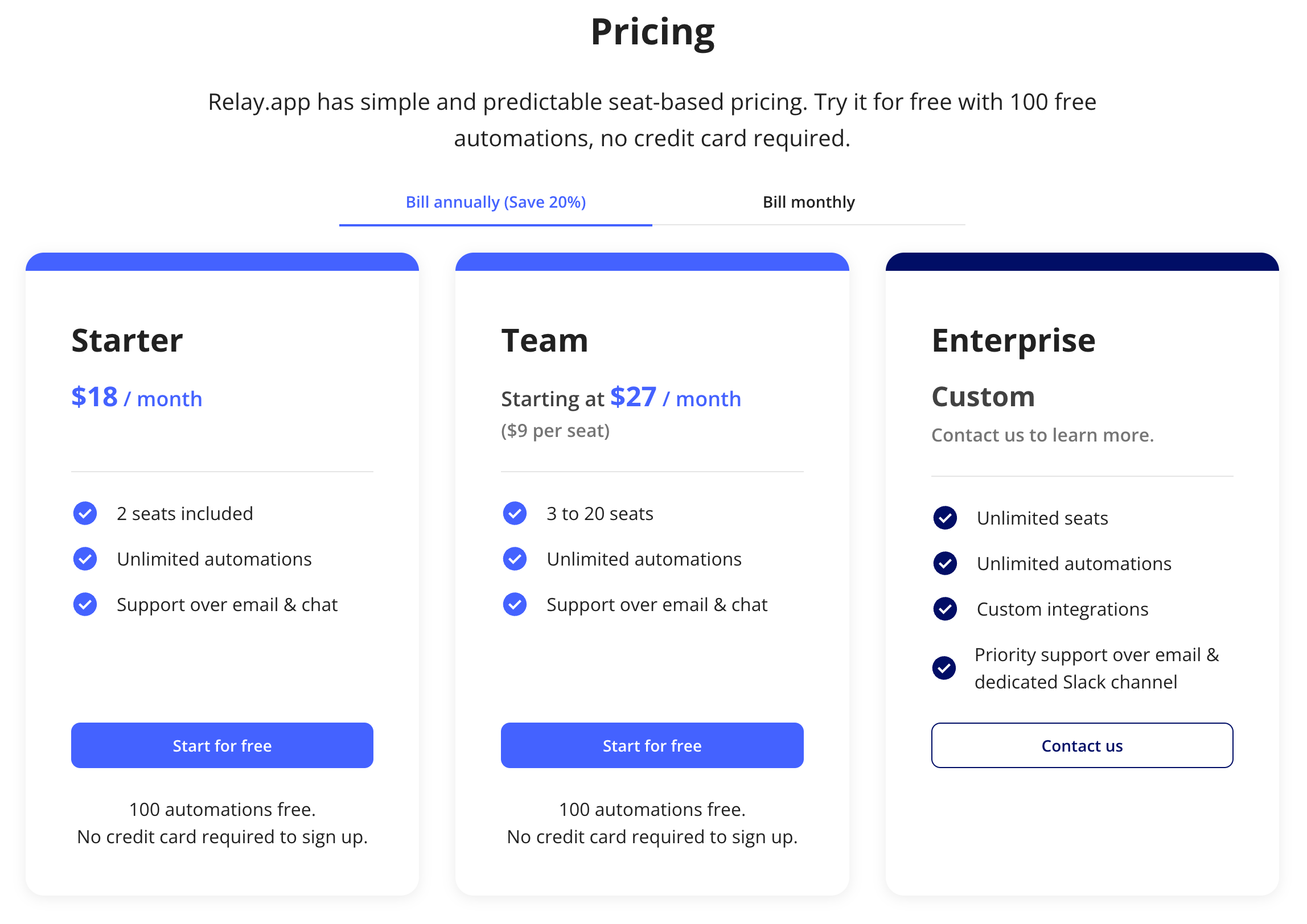
As you can see from the above, Relay.app has a really straightforward pricing policy with no hidden costs.
The pricing is entirely user-based, meaning you get unlimited automations and access to Relay.app’s features with every pricing plan, and pay only for the users you need to have on board.
Pipedream
The concept of credits is the first thing you need to understand to get a complete picture of Pipedream’s pricing policy.
As stated on its website, “Pipedream charges one credit per 30 seconds of compute time with 256MB of memory, with a minimum of 1 credit per workflow execution.”
This is important because Pipedream’s pricing depends on credits to a certain extent.
Its free forever plan includes up to 300 credits per month, limited to 10 credits per day. You get up to 3 active workflows and 3 connected accounts.
Regarding its paid plans, Pipedream offers a pretty wide range of options to choose from:
- Basic: $45 per month
- Advanced: $149 per month
- Business: $299 per month
- Enterprise: Custom pricing

All the plans include 2,000 monthly credits. If you need more than that, you’ll pay extra, and the cost of each credit will be progressively lower the more credits you spend.
This makes Pipedream’s pricing structure pretty tricky. You won’t always be able to assess the number of credits you require beforehand, meaning the end price might surprise you.
Zapier
The best thing about Zapier’s pricing is that it offers a free forever plan that lets you run 100 free tasks per month and create basic workflows limited to 2 steps alone.
Also, Zapier’s premium apps are omitted from the free forever option.
If you need to build more intricate workflows that include multi-step Zaps, conditional logic, and more tasks per month, you’ll have to choose from one of its paid plans:
- Professional: Starting from $29.99
- Team: Starting from $103.50
- Enterprise: Custom pricing
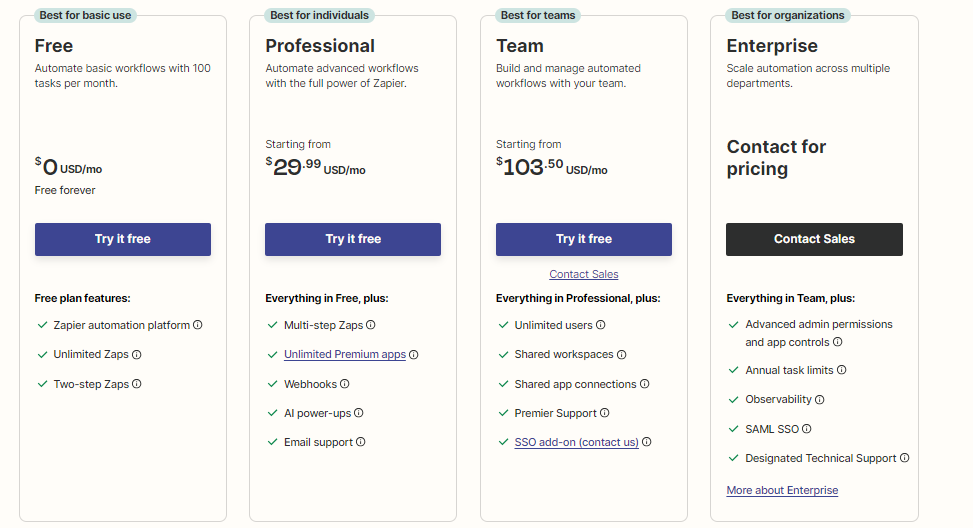
Unlike Relay.app, however, Zapier’s pricing policy isn’t that simple.
Namely, the final price will depend on the number of tasks per month you need automated, meaning that Zapier can quickly become a very expensive solution for users with larger automation volumes.

And that’s not all — remember that you'll have to pay extra to use Tables’ and Interfaces’ more advanced features.
What Are the Users Saying?
It’s one thing to hear it from us and entirely different from the people who’ve used Relay.app, Pipedream, or Zapier.
So now, let’s see what the customers of each platform have to say about their features, use cases, and shortcomings.
Relay.app Reviews

“The tool is flexible and powerful, allowing us to extend workflows in a lot of different directions. The team and support are great - they listen to our needs and help solve our problems quickly.
Best of all is the user-friendliness. Our team is lean. Relay is intuitive and allows all members of our team to build powerful automations so they can do more with less.” - G2 Review
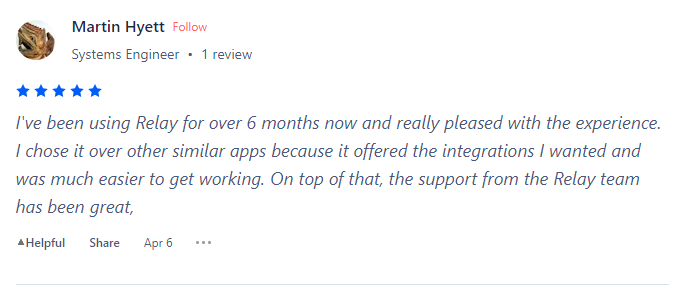
“I've been using Relay for over 6 months now and really pleased with the experience. I chose it over other similar apps because it offered the integrations I wanted and was much easier to get working. On top of that, the support from the Relay team has been great.” - Product Hunt Review
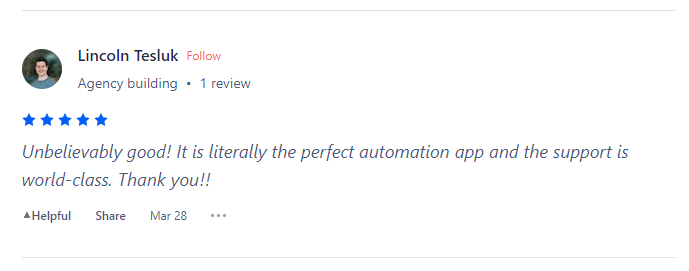
“Unbelievably good! It is literally the perfect automation app and the support is world-class. Thank you!!” - Product Hunt Review
Pipedream Reviews
Pipedream user reviews prove the point we made above, as most customers have a strong technical background and emphasize Pipedream’s benefits for DevOps and software engineers.
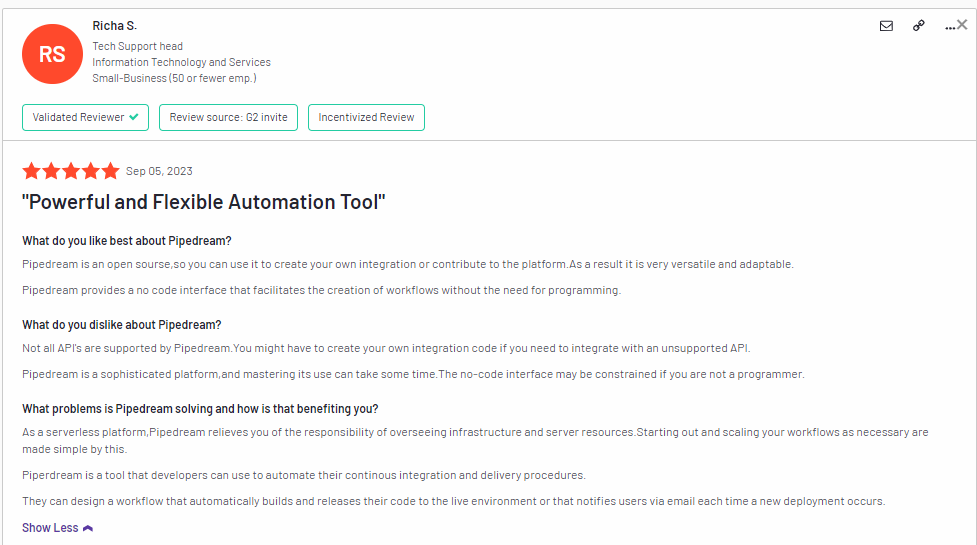
“Pipedream is a sophisticated platform, and mastering its use can take some time. The no-code interface may be constrained if you are not a programmer.” - G2 Review
Also, a significant number of users mention Pipedream’s steep learning curve for beginners and issues with interface navigation - especially for non-technical users.
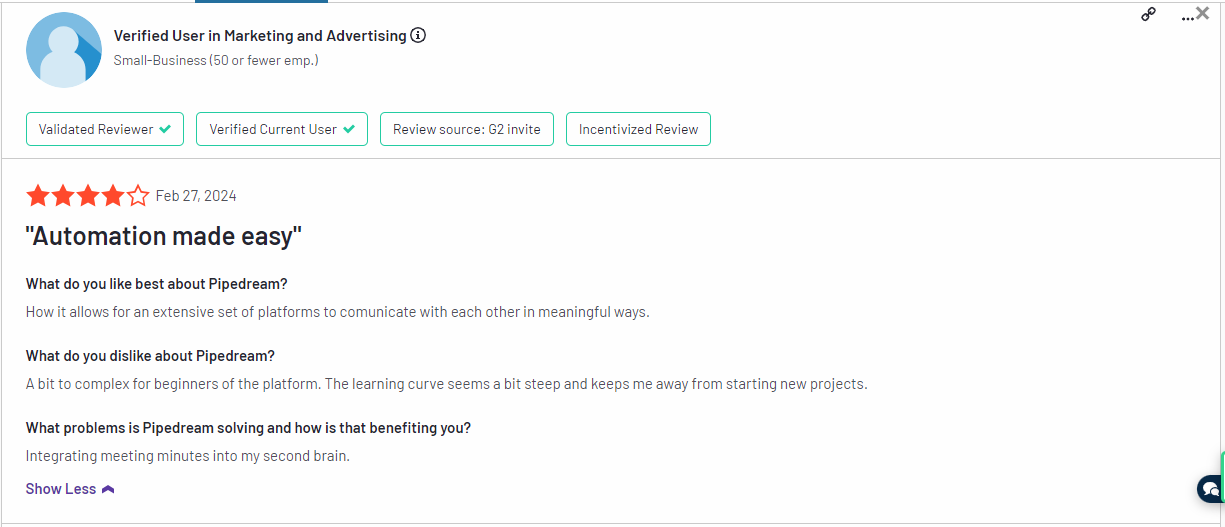
“A bit too complex for beginners of the platform. The learning curve seems a bit steep and keeps me away from starting new projects.” - G2 Review
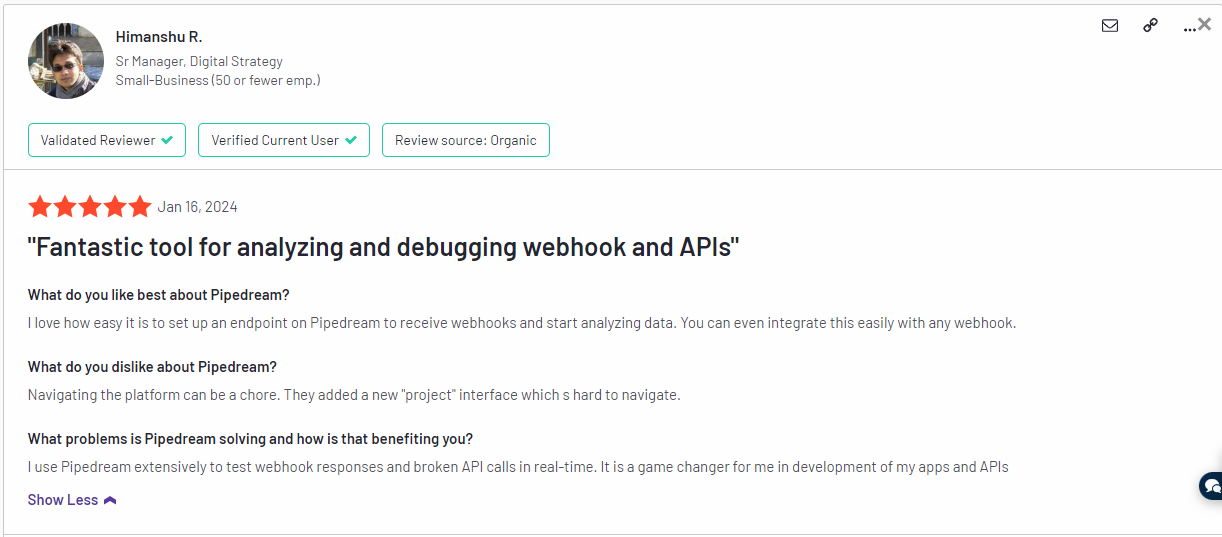
“Navigating the platform can be a chore. They added a new "project" interface which is hard to navigate.” - G2 Review
Therefore, if you can look past the steep learning curve and have sufficient coding expertise, Pipedream is a highly versatile automation solution that offers advanced customization options.
Zapier Reviews
Quite a few of Zapier’s users find its pricing policy one of their biggest challenges, as the free plan can’t get the job done for everyone.

“Premium costing makes it not affordable for small and medium businesses.” - G2 Review
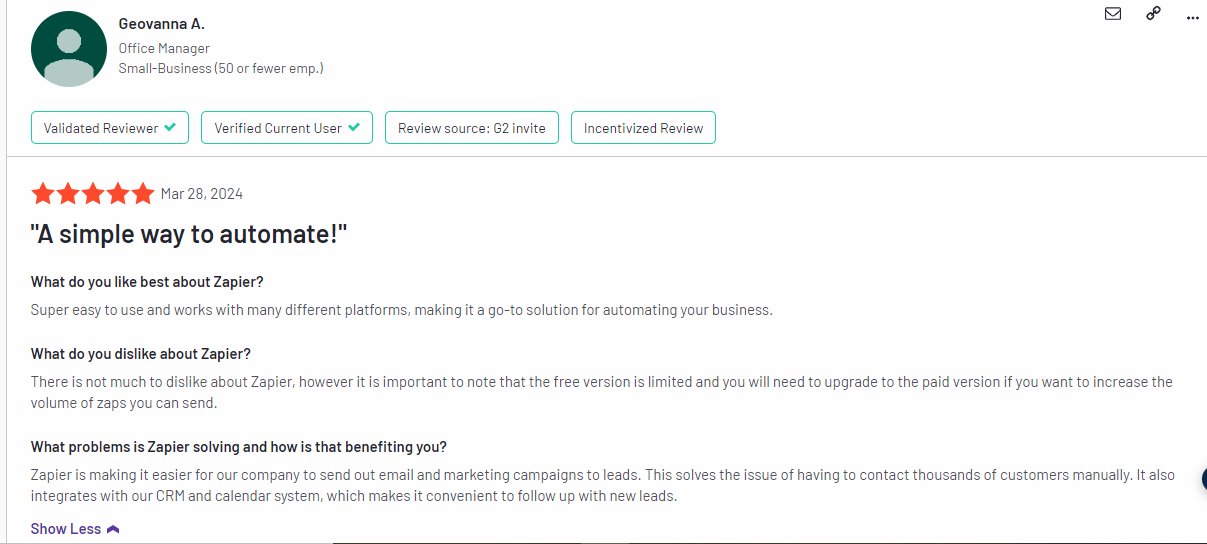
“There is not much to dislike about Zapier. However, it is important to note that the free version is limited, and you will need to upgrade to the paid version if you want to increase the volume of zaps you can send.” - G2 Review
Also, while most users praise Zapier’s user-friendly interface, some bugs and issues can still arise. That wouldn’t be that much of a problem in itself if you had adequate support when it happens.
Unlike Relay.app, Zapier’s customer service team isn’t that helpful and responsive, judging by numerous reviews complaining about it.
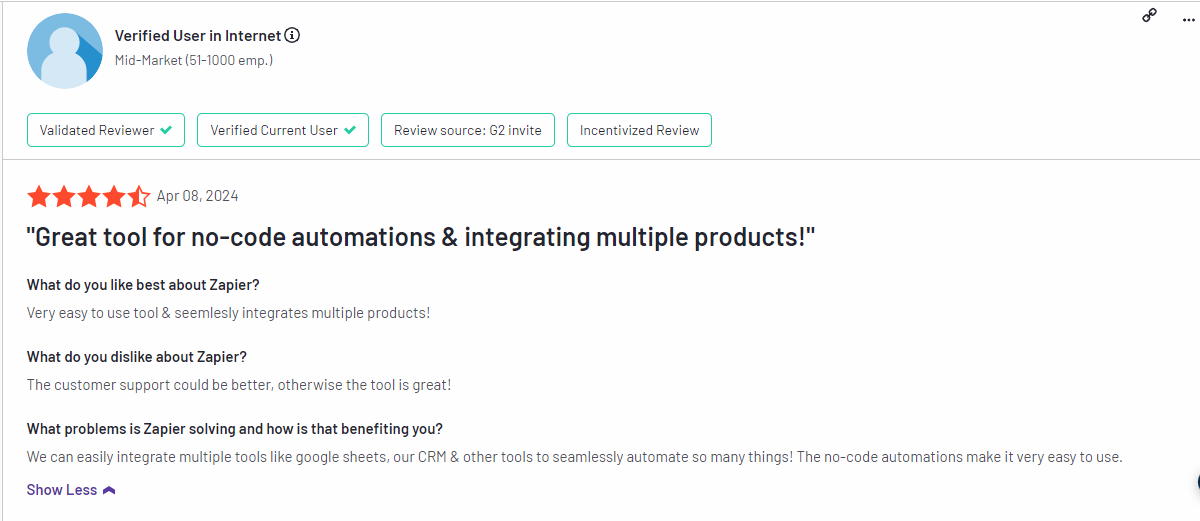
“The customer support could be better. Otherwise, the tool is great!” - G2 Review
Wrapping Up
We hope that after reading this 360-degree overview of Relay. app, Pipedream, and Zapier, you’ll be much more confident about deciding which platform is your ideal pick.
We left no stone unturned in our comprehensive research, ensuring we remain as objective and insightful as possible.
As a parting gift, here are some key takeaways to have in mind when making a choice:
- Relay.app is the perfect choice for teams and individuals looking to get the best of both advanced automation and human emotional intelligence & awareness at an affordable price.
- Pipedream is a great option for tech-savvy users, as only they can make the most of the platform’s powerful capabilities.
- Zapier is best suited for users with limited automation needs, as it can get rather expensive for larger-scale users.
Lastly, because we know who our ideal customers are, we know for sure that Relay.app will fit you if you want to:
- Have a human engaged in your workflows to deal with delicate tasks you’re uncomfortable delegating.
- Streamline and automate even the most complex workflows seamlessly.
- Frictionlessly collaborate on workflows with team members, ensuring that each task is delegated to the most competent person.
- Enjoy the benefits of AI without the downsides of prompt engineering.
- Access unlimited automations and Relay.app’s features with every pricing plan.
💡 Sounds like you? Try Relay.app for free and find out if we’re a match - no credit card needed!

